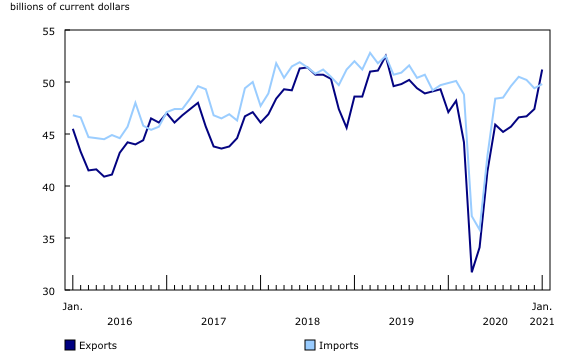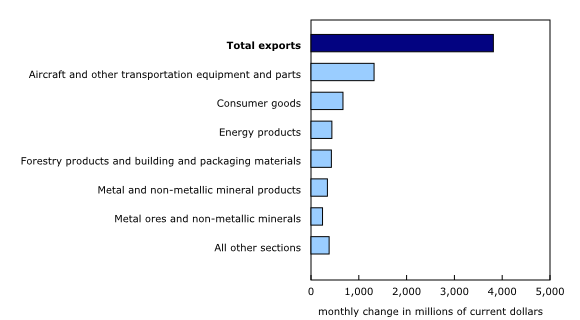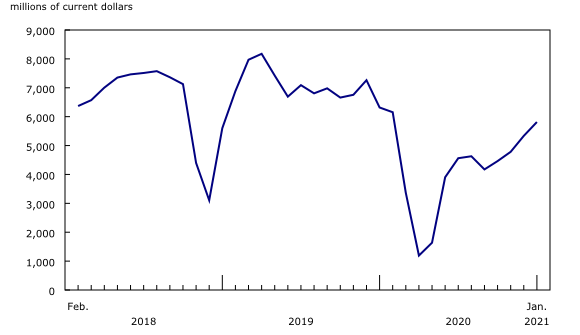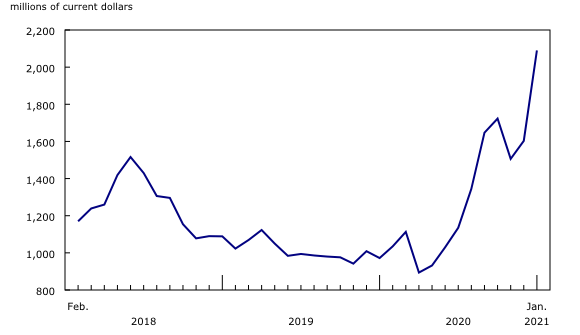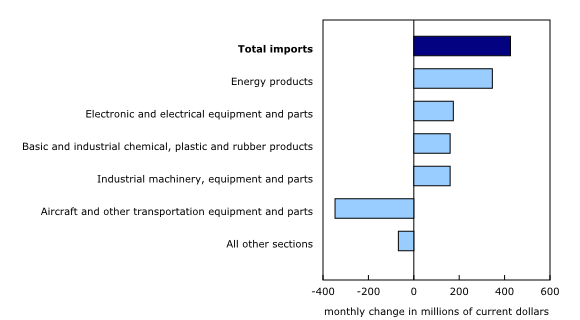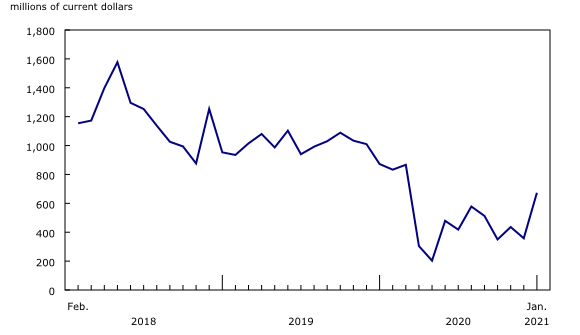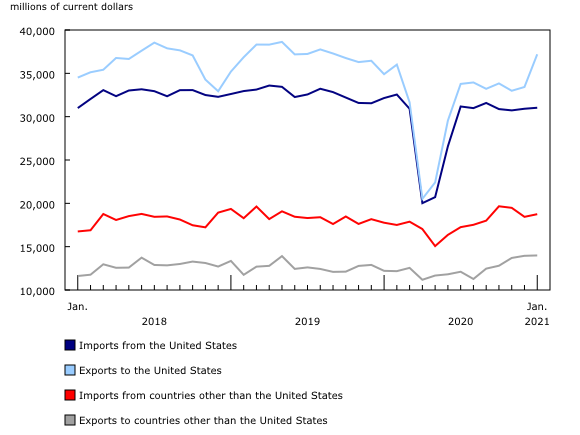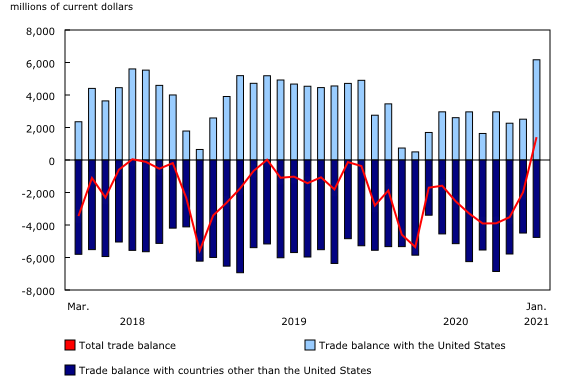Canadian international merchandise trade, January 2021
Archived Content
Information identified as archived is provided for reference, research or recordkeeping purposes. It is not subject to the Government of Canada Web Standards and has not been altered or updated since it was archived. Please "contact us" to request a format other than those available.
Released: 2021-03-05
Canada posted a trade surplus of $1.4 billion in January, the first since May 2019, owing to a sharp 8.1% increase in merchandise exports. It was also the largest surplus since July 2014. Imports rose 0.9% in January compared with the previous month.
To explore the most recent results of Canada's international merchandise trade in an interactive format, see the International merchandise trade monthly interactive dashboard.
Widespread export gains
Total exports rose 8.1% in January to $51.2 billion, with increases in all product sections. This was the largest percentage increase since the rebound in the summer of 2020 that followed the easing of restrictions following the first wave of the pandemic. Excluding the strong fluctuations in 2020, the January increase was the largest since August 1995. Approximately one-third of the increase in the value of exports was driven by price growth. In real (or volume) terms, exports were up 5.1%.
Exports of aircraft and other transportation equipment and parts rose 72.3% in January, mainly on atypical growth in aircraft exports, which more than doubled. A Canadian airline retired a large number of aircraft from its fleet in January, resulting in the export of these used airliners to the United States. Although concentrated exports such as these are unusual for used aircraft, similar shipments are possible over the short and medium term.
Exports of consumer goods were up 11.6% in January, primarily on higher exports of miscellaneous goods and supplies. This category, which includes a wide range of goods, rose by $437 million in January, the largest increase in five years, on higher exports of gold bars to the United States. This type of bar, sold at the retail level to individual investors, is classified within consumer goods, not metal and non-metallic mineral products, which normally includes gold exports to foreign financial institutions. The increase in exports of gold bars in January coincided with higher demand in the United States for this type of investment product.
Exports of energy products rose 5.9% in January, mainly on higher crude oil exports (+9.0%). Higher prices and volumes both contributed to the growth in crude oil exports in January. While volumes were above pre-pandemic levels, prices still lagged, despite the monthly increase.
Exports of forestry products and building and packaging materials (+10.7%) also contributed to widespread growth in January. The increase was largely attributable to lumber exports (+30.4%), which reached a record high $2.1 billion in January. Since April 2020, exports of lumber have risen every month except one, mainly on strong price growth. As explained in the most recent Industrial product and raw materials price indexes releases, demand for lumber has been rising consistently for several months. In January, although prices rose again, the increase was largely attributable to higher volumes. Year over year, the value of lumber exports has more than doubled.
Higher imports of refined petroleum products
Following two consecutive months of decline, total imports increased 0.9% in January to $49.8 billion. Imports rose in 7 of the 11 product sections. In real (or volume) terms, imports were up 1.0%.
Imports of energy products (+20.5%) posted the largest gain in January, mainly on higher imports of refined petroleum products (+87.8%). Strong diesel fuel imports contributed the most to the increase in January. Despite the monthly growth, refined petroleum products imports were down 22.9% year over year.
Imports of electronic and electrical equipment and parts (+2.9%) also contributed to the increase in January. Imports of electronic and electrical parts and of computers and computer peripherals posted the largest increases.
United States behind the gain in total exports
Exports to the United States rose 11.3% in January to $37.2 billion, the highest value since September 2019. The spike in exports of aircraft, gold bars, crude oil and lumber was largely due to stronger trade with the United States. Following the steep declines in the spring of 2020, exports to the United States had remained below pre-pandemic levels. For the first time in January, exports to the United States were higher than February 2020 levels.
Imports from the United States edged up 0.4% to $31.0 billion. As a result, Canada's trade surplus with the United States over doubled from $2.5 billion in December to $6.2 billion in January. This was the largest surplus since September 2008.
When the average exchange rates of December and January are compared, the Canadian dollar gained 0.5 US cents relative to the American dollar. This was the fourth consecutive monthly increase for the Canadian dollar.
Exports to countries other than the United States, which reached a record high in December 2020, edged up 0.3% in January to $14.0 billion. Higher exports to Saudi Arabia (other transportation equipment) was largely offset by lower exports to the United Kingdom (aircraft, oilseeds and gold).
Imports from countries other than the United States rose 1.7% in January. Imports from Switzerland (gold) and Nigeria (crude oil) posted the largest increases.
As a result, Canada's trade deficit with countries other than the United States widened from $4.5 billion in December to $4.8 billion in January.
Revisions to December merchandise export and import data
Imports in December, originally reported as $49.0 billion in the previous release, were revised to $49.4 billion in the release for the current reference month. Exports in December, originally reported at $47.3 billion in the previous release, were revised to $47.4 billion in the release for the current reference month.
Trade in medical and protective goods and vaccines
Following a 16.8% decrease in December, imports of medical and protective goods were down 3.2% in January to $2.6 billion on a customs basis. Although one-quarter (+25.1%) higher year over year, imports in January were at their lowest monthly value since March 2020.
The main contributor to the monthly decline in January was lower imports of diagnostic products (-12.8%). Imports of personal protective equipment (-1.6%) and medical equipment and products (-0.1%) also fell in January.
Exports of medical and protective goods were down 7.3% to $1.2 billion in January, the third consecutive monthly decrease. Despite this monthly decrease, exports were up 5.6% year over year.
Vaccines for immunization against COVID-19 were imported for the second month in January, following approval for use in Canada in December 2020. Imports of these vaccines are reported under the category "vaccines for human medicine other than for influenza", which includes vaccines for a variety of illnesses other than and including COVID-19.
In 2018 and 2019, imports in this category declined by over half (-55%) from December to January. This year, imports increased 21.4% to $56 million, up 73.7% year over year.
It is estimated that Canada's imports of COVID-19 vaccines were approximately $24 million in January. Without imports of the COVID-19 vaccines, imports of vaccines for human medicine other than influenza would have decreased in January and been at a value on par with the import value in January 2020.
Import values for COVID-19 vaccines are preliminary and are subject to revision. Given that the reporting basis of these data may be different than other publicly available sources of information, caution should be exercised in inferring information based on combining these sources.
Monthly trade in services
In January, monthly service exports were up 0.5% to $9.3 billion. Service imports increased 2.7% to $9.5 billion.
When international trade in goods and international trade in services are combined, exports increased 6.8% to $60.4 billion in January, while imports rose 1.1% to $59.3 billion. As a result, Canada's trade surplus with the world for goods and services combined was $1.2 billion in January.
Note to readers
Merchandise trade is one component of Canada's international balance of payments (BOP), which also includes trade in services, investment income, current transfers, and capital and financial flows.
International trade data by commodity are available on both a BOP and a customs basis. International trade data by country are available on a customs basis for all countries and on a BOP basis for Canada's 27 principal trading partners (PTPs). The list of PTPs is based on their annual share of total merchandise trade—imports and exports—with Canada in 2012. BOP data are derived from customs data by adjusting for factors such as valuation, coverage, timing and residency. These adjustments are made to conform to the concepts and definitions of the Canadian System of National Accounts.
For a conceptual analysis of BOP-based data versus customs-based data, see "Balance of Payments trade in goods at Statistics Canada: Expanding geographic detail to 27 principal trading partners."
For more information on these and other macroeconomic concepts, see the Methodological Guide: Canadian System of Macroeconomic Accounts (13-607-X) and the User Guide: Canadian System of Macroeconomic Accounts (13-606-G).
The data in this release are on a BOP basis and are seasonally adjusted. Unless otherwise stated, values are expressed in nominal terms, or current dollars. References to prices are based on aggregate Paasche (current-weighted) price indexes (2012=100). Movements within aggregate Paasche prices can be influenced by changes in the share of values traded for specific goods, with sudden shifts in trading patterns—as observed currently with the pandemic—sometimes resulting in large movements in Paasche price indexes. Volumes, or constant dollars, are calculated using the Laspeyres formula (2012=100), unless otherwise stated.
For information on seasonal adjustment, see Seasonally adjusted data – Frequently asked questions.
Revisions
In general, merchandise trade data are revised on an ongoing basis for each month of the current year. Current-year revisions are reflected in both the customs-based and the BOP-based data.
The previous year's customs-based data are revised with the release of data for the January and February reference months, and thereafter on a quarterly basis. The previous two years of customs-based data are revised annually, and revisions are released in February with the December reference month.
The previous year's BOP-based data are revised with the release of data for the January, February, March and April reference months. To remain consistent with the Canadian System of Macroeconomic Accounts, revisions to BOP-based data for previous years are released annually in December with the October reference month.
Factors influencing revisions include the late receipt of import and export documentation, incorrect information on customs forms, the replacement of estimates produced for the energy section with actual figures, changes in merchandise classification based on more current information, and changes to seasonal adjustment factors.
For information on data revisions for exports of energy products, see Methodology for Exports of Energy Products within the International Merchandise Trade Program.
Revised data are available in the appropriate tables.
Real-time data table
The real-time data table 12-10-0120-01 will be updated on March 22.
Next release
Data on Canadian international merchandise trade for February will be released on April 7.
Products
The product International merchandise trade monthly interactive dashboard (71-607-X) is now available. This new interactive dashboard is a comprehensive analytical tool that presents monthly changes in Canada's international merchandise trade data on a balance of payments basis, fully supporting the information presented every month in the Daily text.
The product The International Trade Explorer (71-607-X) is now available online.
Customs-based data are now available in the Canadian International Merchandise Trade Database (65F0013X).
The updated Canada and the World Statistics Hub (13-609-X) is now available online. This product illustrates the nature and extent of Canada's economic and financial relationship with the world using interactive graphs and tables. This product provides easy access to information on trade, investment, employment and travel between Canada and a number of countries, including the United States, the United Kingdom, Mexico, China, Japan, Belgium, Italy, the Netherlands and Spain.
Contact information
For more information, contact us (toll-free 1-800-263-1136; 514-283-8300; STATCAN.infostats-infostats.STATCAN@canada.ca).
For more information, or to enquire about the concepts, methods or data quality of this release, contact us (toll-free 1-800-263-1136; 514-283-8300; STATCAN.infostats-infostats.STATCAN@canada.ca) or Media Relations (613-951-4636; STATCAN.mediahotline-ligneinfomedias.STATCAN@canada.ca).
- Date modified:



